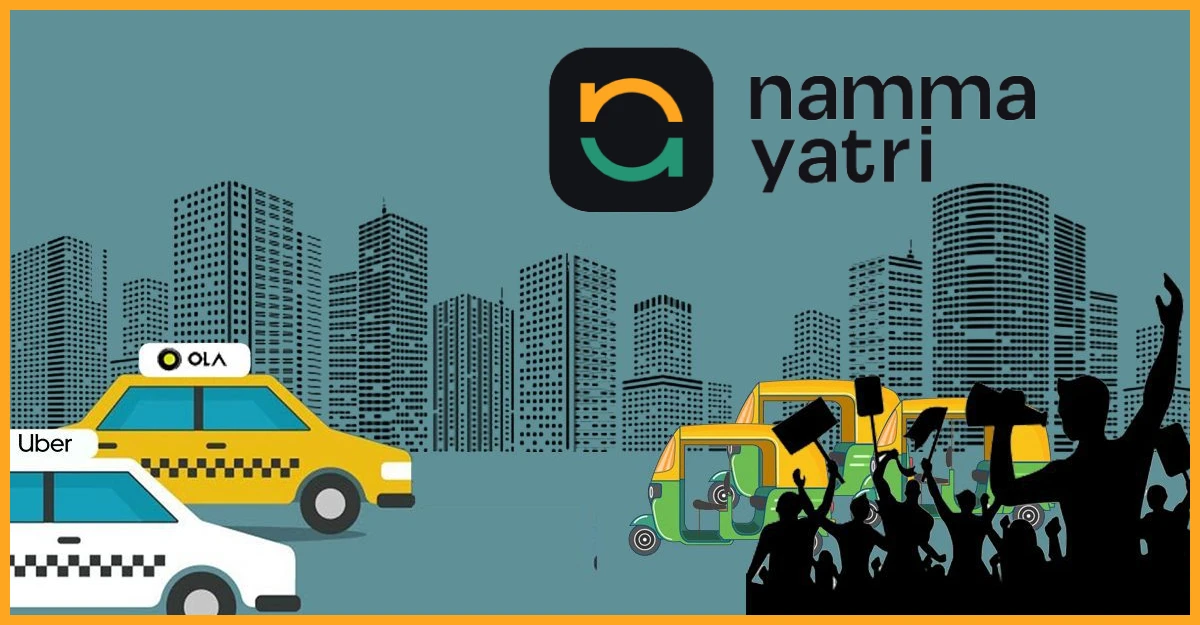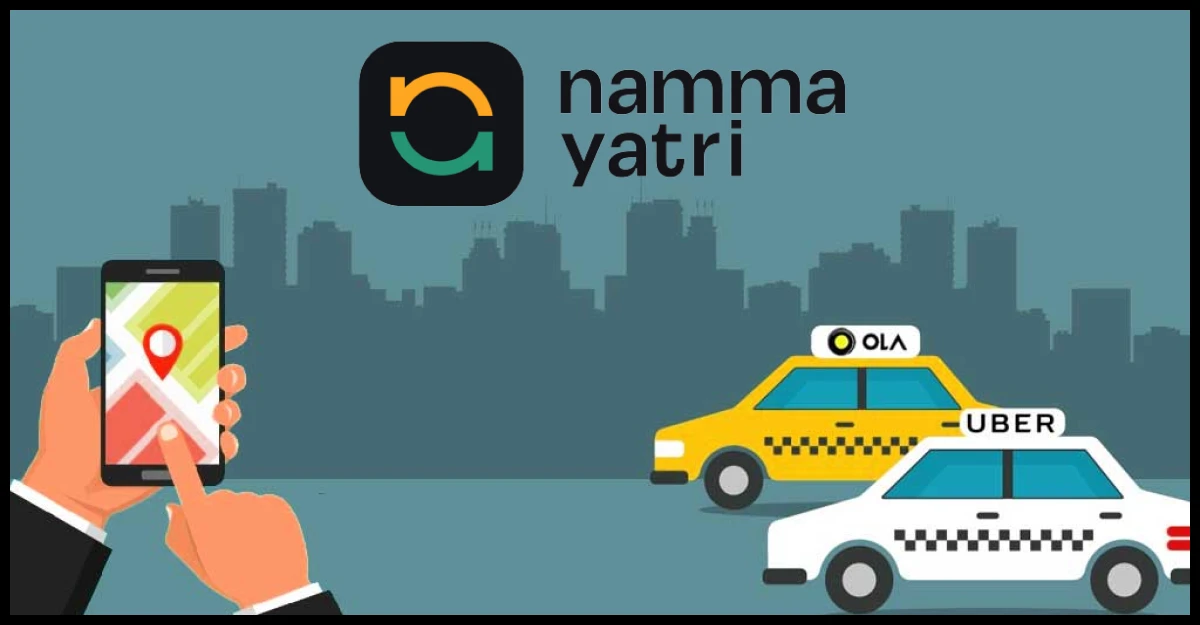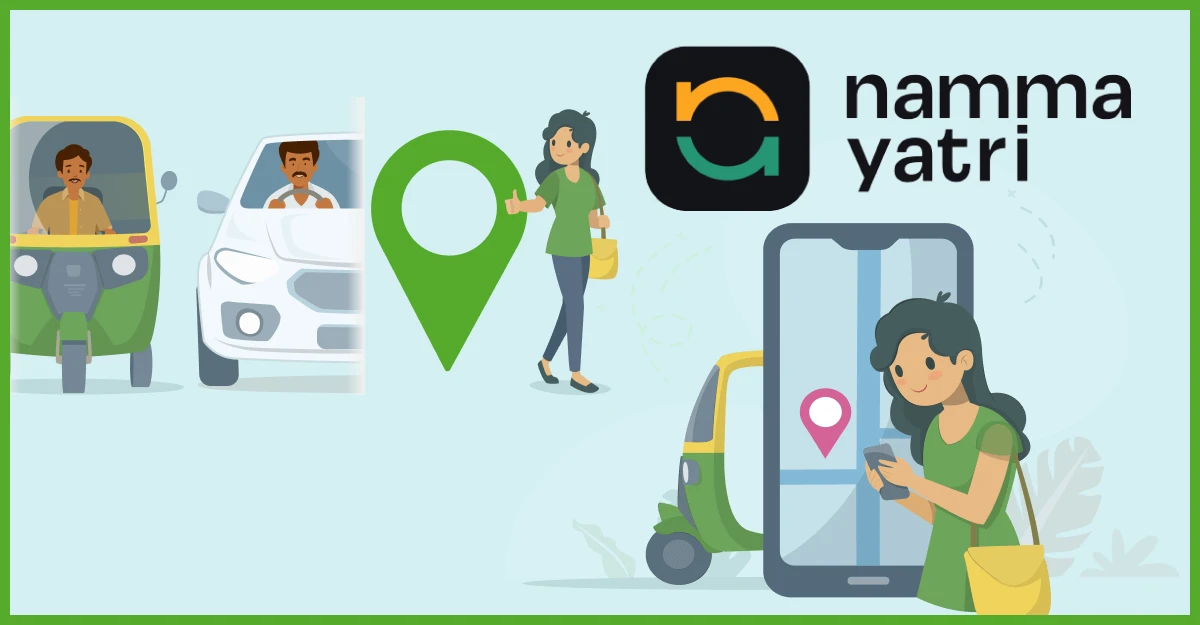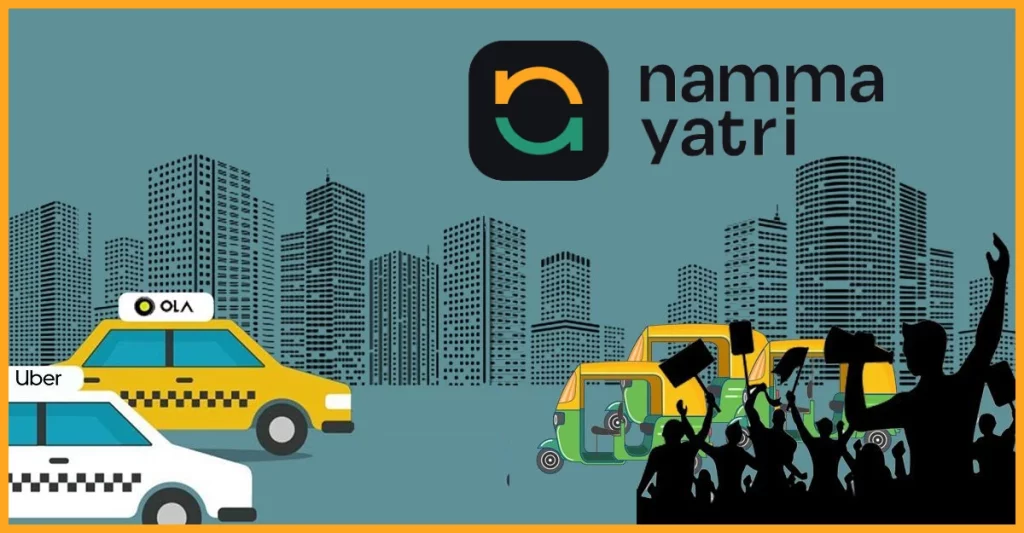Namma Yatri has become a new ray of hope for drivers and a source of headache for Uber & Ola! Do you know, why? Just go through this write-up and you’ll know it all!

(A) Synopsis: Emerging Battle of Namma Yatri vs Uber & Ola
In January 2024, Namma Yatri (Bengaluru-based ride-hailing platform) finally spread its wings to Delhi. This move not only caught the eyes of customers but also became a sigh of relief for drivers! Why? You may ask…
Just look at the stressful statement of an auto driver-
“I lose a minimum of Rs 20-30 on every ride on Ola and Uber, sometimes going up to Rs 80-90 for rides over Rs.300. It’s my auto, my license, my gas, and I still have to work for and be at the mercy of someone else. It’s unfair…”
Let’s talk about another scenario. While riding the Ola/Uber cab, the driver must have asked you to cancel the ride on the app and pay the rent directly to the driver. Have you wondered why? Because they wanted to save the commission and earn a little bit more. Guess what? The commission soars up to 30% in the aggregator apps!
But a new ray of hope emerged as soon as the drivers began using Namma Yatri. How? Namma Yatri works on a “No Commission” model due to which they don’t lose their money like those of Uber, Ola, Rapido, etc.
That’s the story of almost every driver working in ride-hailing services. By seeing the benefits of Namma Yatri numerous drivers are switching to it from Ola and Uber. This act is enough to cause too much stress to the dominating ride-hailing platforms of India!
(B) What is Namma Yatri?
Namma Yatri is an innovative open-network mobility application designed to provide convenient and transparent transportation services.
Supported by a non-profit organization led by Nilekani and developed by a company called ‘Juspay,’ this service plans to expand its reach by becoming part of the Open Network for Digital Commerce (ONDC). To the uninitiated, let me tell you that ONDC is a government initiative aimed at making digital commerce more accessible to everyone.
We have a dedicated article on “What is ONDC? An explainer on the new tech revolution of India.” You can go through it to have detailed information about ONDC!
(C) How Namma Yatri is Different from Uber & Ola?
Here are the key differences between Namma Yatri and Uber & Ola-
| Differential Aspects | Namma Yatri | Uber & Ola |
| Ownership | Built by ‘Juspay’ and supported by the non-profit Foundation for Interoperability in Digital Economy (FIDE) | Privately owned companies |
| Commission | No commission is charged to drivers | Commission charged to drivers (percentage of fare) |
| Platform Control | Not platform-based, drivers have more control | Platform-based, company controls pricing and operations |
| Licensing | Not regulated like Ola and Uber | Requires specific licensing for operation |
| Payment Options | (Direct Payment to drivers)Cash or UPI | Payment via apps (Multiple options including UPI, card payments, wallets) |
| Rider Experience | Riders mention lower prices compared to Ola and Uber but experience long waiting times and tech issues | Convenient booking process, multiple payment options, established service |
| App Features | Basic features for booking and payment | Advanced features for ride-hailing and navigation |
| Integration with ONDC | Recently became part of the ONDC network | Not integrated with ONDC |
In this comparison, we have assumed Uber and Ola as similar mobility platforms due to the similarity of their services. However, you must know that there are significant differences between the two. We have thoroughly explained “Ola vs Uber: Which one is doing better business in India?” You can go through the article to have a better understanding!
(D) Data Comparison: Namma Yatri vs Ola & Uber
Let’s compare the revenue, YOY growth, and leverage of Namma Yatri vs Ola & Uber-
| Aspects (FY22-23) | Namma Yatri | Ola | Uber (India) |
| Revenue | Rs.12.5 crore (driver’s revenue) | Rs.1,208.6 crore | Rs.388.2 crore |
| Year-on-Year growth | 115% | 78.5% | 29.5% |
| Leverage | Zero expenditure in marketing. Revenue collected mainly from Bengaluru and Mysuru. All the revenue is directly given to drivers | Revenue collected from various verticals & sources including financial services | Prime source of revenue is its ride-hailing business |
Now, let’s analyze the comparison-
- Namma Yatri’s Bengaluru Focus: Namma Yatri’s impressive ride-hailing revenue of over INR 12.46 crore, earned without splurging on marketing, is quite a feat. By ensuring all earnings go straight to the drivers, the company has shown it cares about them, which could be why it’s growing so fast and attracting more drivers.
- Ola’s Diverse Income: Ola’s ride-hailing revenue surged by 78.5% year-on-year, but it’s not just rides that bring in the cash. Ola makes money from other services too, like financial services, making its income more varied compared to others.
- Uber’s Ride-Hailing Dominance: Uber India mainly relies on ride-hailing for its income, which makes up 98% of its total earnings. Despite its substantial growth, Namma Yatri, a local player, is outpacing Uber’s growth without spending much on marketing.
In essence, Namma Yatri’s focused approach in Bengaluru has helped it to collect significant revenue, putting it on par with the big players in the city’s ride-hailing scene.
(E) Beneficial Aspects of Namma Yatri over Uber & Ola
Namma Yatri works on a different business model than Ola & Uber. Yes! And that’s what it differentiates itself from those two. Let’s peep into Namma Yatri business model and how is it different from Ola & Uber-

(E.1) No Commission Business Model: Direct Payment to Drivers
Namma Yatri differentiates itself by offering zero commission to auto-rikshaw drivers. Unlike Uber and Ola, which charge up to 30% commission from drivers, Namma Yatri ensures that drivers receive 100% direct payment for each ride. For drivers, this is immensely attractive because they no longer lose a significant portion of their earnings to commissions. The absence of commissions also eliminates the need for drivers to ask customers to cancel rides and pay them directly, a practice that has been observed with other aggregator apps.
(E.2) Transparent Pricing
When you book a ride on Namma Yatri, the estimate shown to you is the same as what the driver sees. There’s no hidden commission or additional charges. This transparency ensures that riders and drivers clearly understand the fare, fostering trust and simplicity in the transaction process. In contrast, Uber and Ola have sometimes faced criticism for inaccurate estimates and high prices.
(E.3) Independent Platform
Unlike platform-based apps like Ola and Uber, Namma Yatri is not controlled by a centralized entity. It allows drivers more control over their pricing, operations, and decisions regarding their involvement with the app. The platform independence of Namma Yatri is more like a platform where drivers and passengers connect directly, without any middlemen taking a cut.
(E.4) Revenue Streams
The primary revenue stream for Namma Yatri is expected to come from subscription fees paid by auto drivers. This subscription model could involve a per-ride charge or a fixed subscription fee, which would provide drivers access to the platform’s services and features.
Here things get interesting! The subscription fee of ONDC-based Namma Yatri is going to be much less than the commissions gulped by privately held ride-hailing services like Ola and Uber.
(E.5) Direct Interaction with Drivers
Namma Yatri connects commuters directly with auto drivers, bypassing any middlemen. Once you request a ride, an auto-rickshaw arrives at your doorstep, and you pay the driver directly (either in cash or through UPI) at the end of the ride. This direct interaction streamlines the process and eliminates the need for complex payment systems or intermediary platforms like Ola and Uber.
(E.6) Partnerships & Collaborations
Namma Yatri collaborates with tech companies like Juspay for app development and support. Additionally, it aims to partner with organizations and unions to gather insights and build a product tailored to the needs of the drivers.
(E.6) Long Term Sustainability
To sustain its operations, Namma Yatri plans to optimize costs, explore open-source alternatives for mapping services, and potentially introduce a subscription model for drivers. This model aims to keep costs low while ensuring drivers have access to the necessary tools and support.
That’s how the business model of Namma Yatri revolves around providing a platform for auto drivers to connect directly with commuters, bypassing traditional aggregator-based models like Ola and Uber!
(F) Growth: How is Namma Yatri performing so far?
Let’s look at the snapshot of Namma Yatri’s performance-
| Particulars | Performance Metrics | Inference |
| Completed Trips | 8,429,602 rides | Over 8 million rides completed |
| Registered Drivers | 90,722 drivers | Nearly 91,000 drivers signed up |
| Users on board | 1,776,216 registered users | More than 1.7 million people are using the app |
| Driver Earnings | INR 1,245,597,910 | Drivers have earned a total of over INR 1.2 billion |
These numbers show that Namma Yatri is growing rapidly, with lots of people using the app to get around Bengaluru. There are also plenty of drivers available, and they’re earning a good amount of money through the platform. Overall, it seems like Namma Yatri is becoming a popular choice for both riders and drivers in the city.
(G) Challenges faced by Namma Yatri

Some of the major challenges faced by Namma Yatri are-
(G.1) Limited Ride Availability
- During off-peak hours, there’s a significant decrease in the number of available rides for drivers on the Namma Yatri app.
- Data from the open data dashboard on Namma Yatri’s website revealed that on a Sunday evening, there were 6,433 available drivers but only 543 ongoing rides, indicating a low ride-to-driver ratio.
- This scarcity of rides during certain periods poses a challenge for drivers who rely on consistent income throughout the day.
(G.2) Technical Issues and User Experience
- Some users reported long waiting times for ride confirmations and difficulties in finding nearby autos through the app.
- Complaints about slow loading times, interface glitches, and high failure rates during booking contribute to a less-than-ideal user experience.
- These technical challenges may deter users from using the app regularly, impacting its growth and adoption rate.
(G.3) Financial Sustainability and Operations
- Running a ride-hailing app like Namma Yatri requires continuous investment in engineering, research and development, marketing, and map services.
- While the initial operations are backed by the Foundation for Interoperability in Digital Economy (FIDE), sustaining the app in the long term necessitates generating revenue to cover operational costs.
- Exploring a subscription model to be paid by auto drivers raises concerns about affordability and transparency, with some drivers apprehensive about potential hidden costs.
(G.4) Competition & Market Dominance
- Namma Yatri operates in a highly competitive market dominated by established players like Ola and Uber.
- These competitors have significant market shares and vast resources, making it challenging for Namma Yatri to carve out its niche and attract both riders and drivers.
- Overcoming the dominance of these platforms requires innovative strategies and compelling value propositions to differentiate Namma Yatri from its competitors.
(G.5) Regulatory and Policy Challenges
- Implementing a subscription model and navigating state-level regulations pose regulatory challenges for Namma Yatri.
- Ensuring compliance with existing regulations while introducing new payment models requires coordination with relevant authorities and stakeholders.
- Adapting to evolving regulatory frameworks and addressing potential legal hurdles is essential for the sustainable growth and operation of the platform.
Addressing these challenges is crucial for Namma Yatri to continue its success and expansion in the ride-hailing industry.
(H) Final Thoughts: Can Namma Yatri compete with Uber & Ola?
In the competitive ride-hailing market dominated by giants like Ola and Uber, Namma Yatri is on a mission to stand out. Their strategy? Focus on app development, improve user experience, and reduce ride cancellations.
As you have read above, Namma Yatri’s approach is different because it lets you pay auto drivers directly, cutting out middlemen fees. This fair approach attracts both drivers and passengers. Namma Yatri is working hard to make its app better and reduce ride cancellations. By teaming up with ONDC, it’s getting more attention.
But there are challenges, like fixing app glitches and figuring out fair payment models for drivers. Despite this, Namma Yatri’s determination to improve and its plan to include more types of transport show it’s serious about competing.
While it’s not easy, Namma Yatri has the potential to shake things up and offer a fresh choice for getting around!


Is Namma Yatri as safe as Ola or Uber?